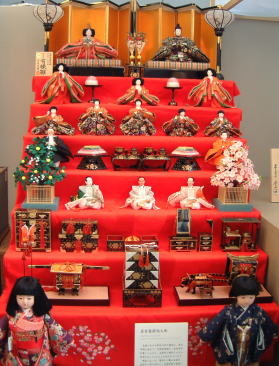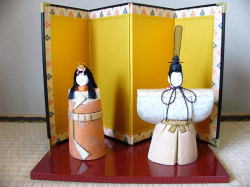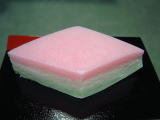 |
top | (left) Empress/ ohinasama <---- > (right) Emperor/odairisama Kyoto or Osaka arrangement (traditional way) In Kanto area (Tokyo area), they arrange opposite way |
| 2nd | Three court ladies ( sannin kanjo ) (left) with "hisageñ ", (center) with "samboOû", (right) with "choshi¶q" The lady sit in the center doesn't have eyebrows because she is married. |
|
| 3rd | Court band/( gonin bayashi ) (left) with taiko/drum ¾Û, with O-tsuzumi/OkawaåÛ, (center) Kotsudumi/Kokawa¬Û, fue/fluteJ, (right) utai/singerw |
|
| 4th | Two ministers/( zuijin ) Generally they are called "U-daijin (minister of the right) and Sa-daijin" (minister of the left). However, actually, they are officers who guard the Palace gates, etc. (left)Udaijin [young one], (right) Sadaijin[old one] |
|
| 5th | Three court officials/(jichou, shitei or shichou) (Left) DaigasaäPparasol, (center) kutsudai BästoolA(right)Tategasa §P/umbrella |
|
| 6th | miniature furniture | |
| 7th | litter and ox-drawn imperial coach | |
| extra | ichimatsu-dolls | |
| Hina dolls ( Hina ningyou ) | They are arranged on several tiers of shelves covered with red fablic.or hi-mousen |
|

